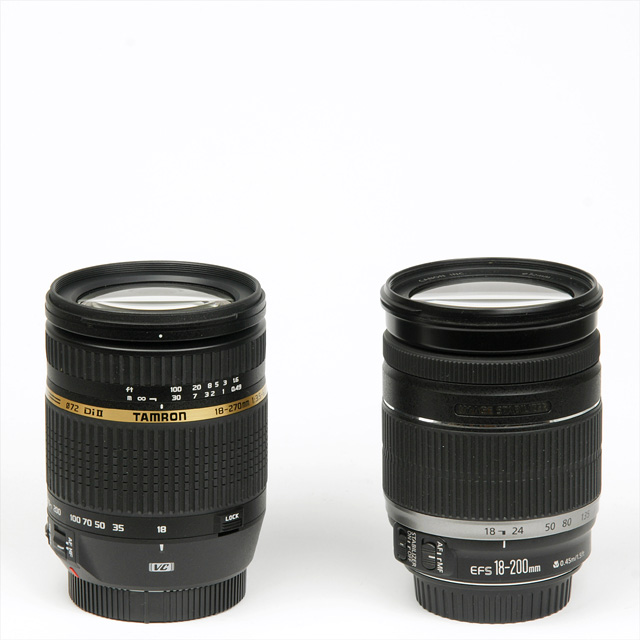|
Tamron AF 18-270mm f/3.5-6.3 Di II LD [IF] Asph. VC macro - Review / Test Report |
|
Lens Reviews -
Canon EOS (APS-C)
|
|
Page 1 of 3

Review by Klaus Schroiff, published January 2009
Introduction
There's not only a mega-pixel war out there, we're also seeing a race for the highest zoom ratio in lens land. Tamron has always been at the forefront of providing extreme range zoom lenses. The relatively new Tamron 18-250mm f/3.5-6.3 does already provide a class-leading performance (class-leading = "good") but it falls a little short in one important aspect: it may provide the highest zoom ratio (13.9x) of the industry combined with decent quality but it does not offer any optical image stabilization. This is obviously a shortcoming, at least on Canon and Nikon DSLRs, because e.g. 250mm f/6.3 does already require high ISO settings in less than optimal light conditions. Tamron listened obviously because they just released a new variant of the story - the Tamron AF 18-270mm f/3.5-6.3 Di II LD Aspherical [IF] VC macro (boy, what a name ...). Apart from the usual marketing bla-bla there's an interesting abbreviation here - "VC" = "Vibration Compensation" - more commonly known as image stabilization. All image stabilization lenses share the same basic idea: one element or lens group is shifted out of its optical alignment (forced decentering) in order to tilt the optical axis and to counteract shake. As you may imagine it requires quite a bit of engineering skills to avoid significant image quality deteriorations. The Tamron system has a adjustment frequency of 4000 changes per second on 3 axes (as opposed to the usual 2) and they claim an efficiency similar to ~4 f-stops. As always you should take such statements with a grain of salt but the VC worked well during the field sessions. And, oh yes, the lens offers a little extra range (20mm) on top so the peak in terms of zoom ratio has been pushed to 15x now. The field-of-view of this dedicated APS-C format lens is equivalent to "29-432mm" (full format) so it's an all-purpose wonder, albeit a slow speed one (f/3.5-6.3) especially at 270mm.
 In terms of build quality the Tamron is a fairly typical consumer grade zoom lens. Most of the outer construction is made of plastic except for the metal mount. Zooming isn't really effortless - the broad, rubberized zoom ring has a very high friction especially in the middle range. The small focus ring (rotating in AF mode) operates reasonably smooth although somewhat "lifeless". The lens uses a duo-cam zoom mechanism (two inner lens tubes) to extend towards to long end of the zoom range. At 270mm the lens is about twice as long as full retracted (@ 18mm). Surprisingly the duo-cams showed no significant tendency to wobble despite the extreme extension. The tested sample did not suffer from zoom creeping (which may develop over time) but Tamron implemented a transport lock (18mm only) just in case.
In terms of build quality the Tamron is a fairly typical consumer grade zoom lens. Most of the outer construction is made of plastic except for the metal mount. Zooming isn't really effortless - the broad, rubberized zoom ring has a very high friction especially in the middle range. The small focus ring (rotating in AF mode) operates reasonably smooth although somewhat "lifeless". The lens uses a duo-cam zoom mechanism (two inner lens tubes) to extend towards to long end of the zoom range. At 270mm the lens is about twice as long as full retracted (@ 18mm). Surprisingly the duo-cams showed no significant tendency to wobble despite the extreme extension. The tested sample did not suffer from zoom creeping (which may develop over time) but Tamron implemented a transport lock (18mm only) just in case.

The Tamron uses a conventional AF micro-motor and thanks to a very short focus path (~30 degrees) the AF speed is relatively fast (but slower compared to the Canon EF-S 18-200mm IS). However, this design decision doesn't come for free - manual focusing is very difficult because slight adjustments via the focus ring have a rather massive impact on the focus point. The AF accuracy was fine on the EOS 50D - at least in conventional AF mode (phase detection). The camera struggled somewhat in Live-View mode (contrast AF) though.
It may be interesting to make a little visual comparison to the Canon EF-S 18-200mm f/3.5-5.6 IS here:
Move your mouse pointer in/out of the image to "zoom out".

|
| Specifications |
|---|
| Equiv. focal length | 29-432 mm (full format equivalent) |
| Equiv. aperture | f/5.6-f/10 (full format equivalent, in terms of depth-of-field) |
| Optical construction | 18 elements in 13 groups inc. 1x AD, 2x LD and 3x hybrid aspherical elements |
| Number of aperture blades | 7 |
| min. focus distance | 0.49 m (max. magnification ratio ~1:3.5 @ 270 mm) |
| Dimensions | 80 x 101 mm |
| Weight | 550 g |
| Filter size | 72 mm (non-rotating) |
| Hood | supplied, petal-shaped, snap-on type |
| Other features | Vibration Compensation (VC = Image Stabilizer) |
|